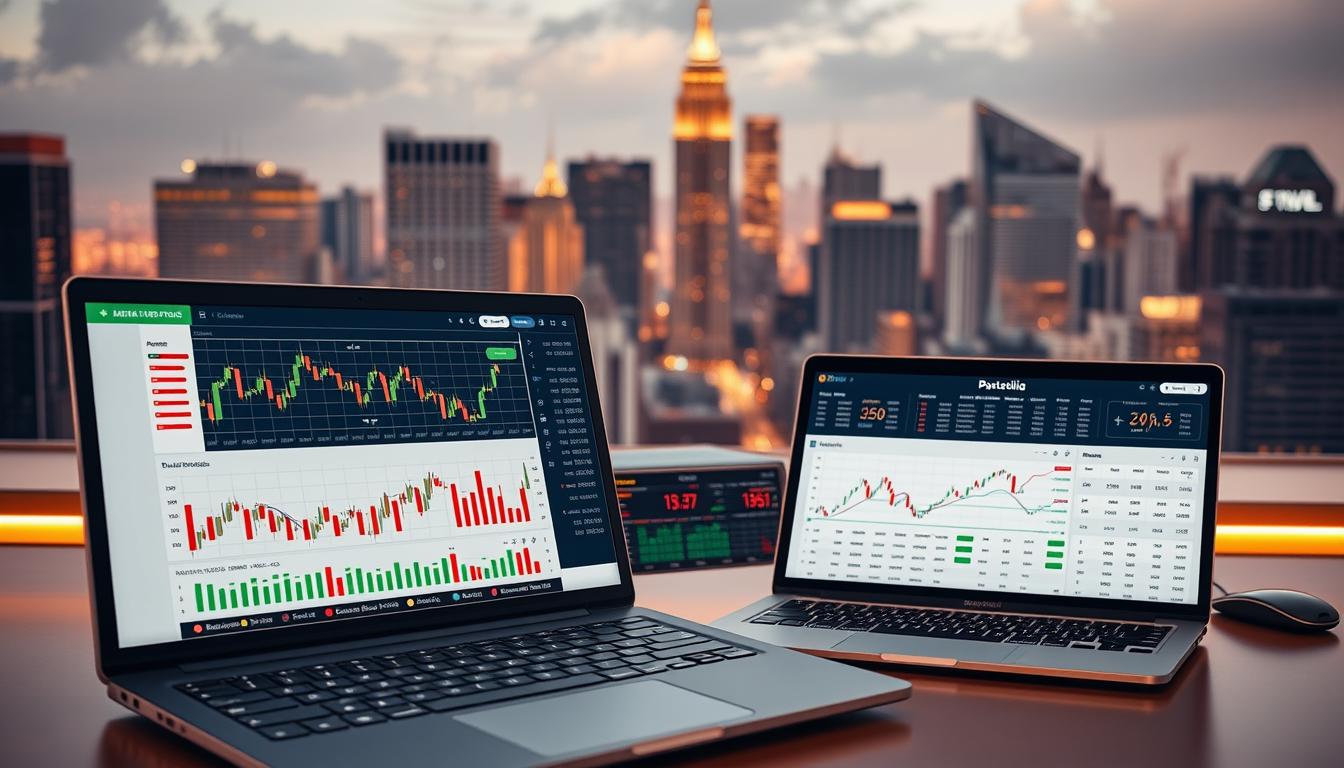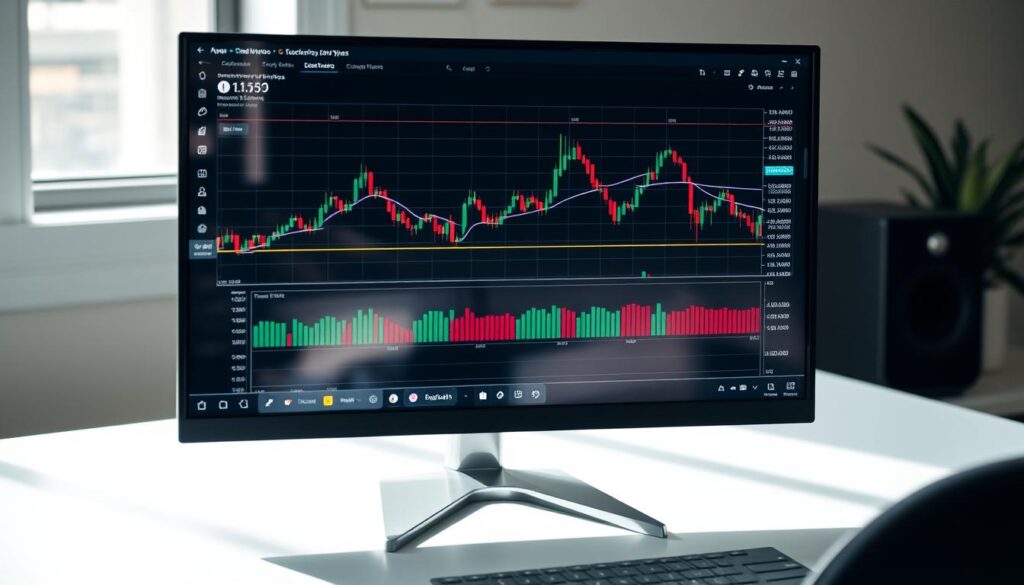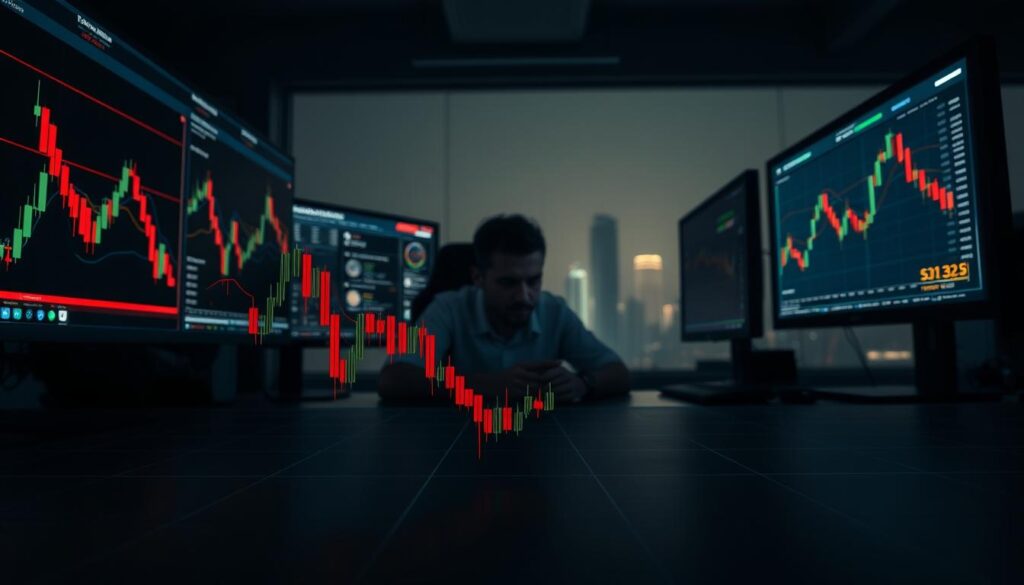Now Reading: How to Analyze Crypto Charts for U.S. Traders
- 01
How to Analyze Crypto Charts for U.S. Traders
How to Analyze Crypto Charts for U.S. Traders

Crypto markets change quickly, and U.S. traders need good ways to keep up. Learning to analyze crypto charts is crucial for making smart choices. Charts reveal price patterns, market mood, and possible chances.
By mastering crypto market analysis, traders can lower risks and find the best times to buy or sell. This is important in a market known for quick changes.
This guide teaches U.S. traders about tools and methods. It talks about SEC rules and IRS reporting, which affect trading strategies. You’ll learn to read charts well, use technical indicators, and avoid common errors.
The goal is to give you practical steps, not just theory. This will help you do better in real markets.
Key Takeaways
- Charts help U.S. traders track price trends and market shifts.
- Regulations from the SEC and IRS impact how traders use chart data.
- Combining technical and fundamental analysis improves decision-making.
- Key indicators like moving averages and RSI are vital for crypto chart analysis.
- Risk management and avoiding overtrading are critical for long-term success.
Understanding the Fundamentals of Cryptocurrency Charts
Learning cryptocurrency analysis techniques begins with understanding price charts. Traders need to know how to read the data. Here are the basics every investor in the U.S. should know.
Types of Crypto Charts Explained
- Line Charts: Simple trend lines showing closing prices over time, ideal for spotting long-term trends.
- Bar Charts: Vertical bars mark open, high, low, and close prices, offering deeper price action details.
- Candlestick Charts: Color-coded bodies and wicks reveal market sentiment, favored by traders for pattern recognition.
Key Components of a Cryptocurrency Chart
Charts have axes and volume bars. Traders look at these to find support and resistance levels. For instance, a Bitcoin chart with rising volume during a price spike shows strong momentum.
Timeframes and Their Role
Timeframes affect how you analyze: 1-minute charts show daily changes, while monthly charts reveal long-term trends. Swing traders often use daily charts for a balance of detail and clarity. Choosing the right timeframe is key to avoiding misinterpretation.
To master interpreting price charts for traders, start with candlestick charts and daily timeframes. This builds a solid foundation before moving to more advanced cryptocurrency analysis techniques.
Getting Started with Crypto Chart Analysis in the U.S. Market
U.S. traders new to crypto chart analysis should start by picking exchanges that follow federal rules. Sites like Coinbase, Binance.US, and Gemini are easy to use and have built-in chart tools. They make it simple to analyze crypto charts for U.S. traders by offering live price data and customizable indicators.
- Choose exchanges licensed by state agencies (e.g., New York BitLicense holders).
- Start with free tools like TradingView or CoinGecko before upgrading to premium platforms.
- Document entries in a trading journal to track patterns and refine strategies.
Beginners should start with big cryptocurrencies like Bitcoin and Ethereum. This helps them get used to market trends. Use 1-hour or 4-hour charts during U.S. market hours (EST) when there’s more liquidity. The best practices for analyzing crypto charts include checking price action against news events. This helps avoid making decisions based on emotions.
Free resources like Binance Academy’s tutorials and Cointelegraph’s market reports are great for learning the basics. Keep your analysis methods up to date with changes in U.S. crypto laws. Sticking to these steps helps build the discipline needed for long-term success.
Essential Technical Analysis Indicators for Cryptocurrency Trading
Learning technical analysis for cryptocurrencies means knowing how to read price movements and market trends. These tools help traders find trends, understand market feelings, and match their strategies with current trends. Each indicator, from moving averages to volume patterns, is designed to handle the fast changes in digital assets and U.S. market conditions.

Moving Averages and Their Applications
Traders use moving averages to cut through noise and find trends. There are a few main types:
- Simple Moving Average (SMA): averages price data over a set period, like the 50-day SMA for long-term trends.
- Exponential Moving Average (EMA): focuses on recent data, great for catching quick price changes.
When short-term MA goes over long-term MA, it signals a trend change. For example, Bitcoin going above its 200-day SMA often shows a bullish trend.
Relative Strength Index (RSI) Strategy
The RSI shows when prices are too high or too low. In crypto, traders use 70 (overbought) and 30 (oversold) levels because of the high volatility. A Bitcoin RSI above 70 might mean a pullback, while below 30 could be a buy signal. But, during strong trends, false signals can happen, so always check with price action.
MACD and Momentum Trading Techniques
The MACD (Moving Average Convergence Divergence) tracks momentum. A bullish signal is when the MACD line goes above the signal line, showing upward momentum. When price hits new highs but MACD doesn’t, it warns of a possible reversal. Traders watch histogram bars to see how strong the momentum is.
Volume Analysis for Crypto Traders
Volume shows if price moves are real. High volume during upswings means strong buying interest. In crypto’s always-on markets, sudden volume jumps often lead to price changes. Tools like Whale Alerts use volume data to track big trader moves, helping U.S. traders avoid false trends.
Recognizing Common Cryptocurrency Chart Patterns
Cryptocurrency chart patterns are key for U.S. traders to forecast price changes. Learning these patterns helps traders match their strategies with market trends. This part will cover common patterns in crypto markets, improving U.S. trader crypto chart analysis.
Bullish vs. Bearish Patterns in Crypto Markets
- Bullish signals include double bottoms, cup-and-handle structures, and ascending triangles, signaling potential upward trends.
- Bearish formations like head-and-shoulders, double tops, and descending triangles indicate possible price declines.
- Crypto markets often exaggerate these patterns due to high volatility, making confirmation with volume data crucial.
Support and Resistance Levels Identification
Finding support (price levels where buying emerges) and resistance (levels where selling pressure rises) is key for setting entry/exit points. Crypto’s 24/7 trading environment means these levels can shift rapidly. Traders must track historical peaks and valleys to anticipate breaks or reversals.
Triangle, Flag, and Pennant Formations
- Symmetrical triangles suggest consolidation before a breakout, common during crypto market uncertainty.
- Flags and pennants mark pauses in strong trends, often followed by continued momentum. Bitcoin’s 2023 rally included multiple flag patterns before price surges.
- These continuation patterns require patience—waiting for breakout confirmation reduces false signals.
Reliable crypto chart patterns may differ from traditional markets due to crypto’s liquidity gaps and rapid news-driven shifts. U.S. traders should back pattern analysis with real-time data and regulatory updates to refine strategies.
How to Analyze Crypto Charts for U.S. Traders: Step-by-Step Approach
To analyze crypto charts for U.S. traders well, follow a clear plan. First, check the market news and SEC updates. Also, look at recent price changes. This helps make choices that fit with what’s happening in U.S. markets.
- Choose your timeframe: Use daily charts for big trends and 1-hour charts for quick changes. U.S. traders watch closely during 8-5 ET hours when prices often change a lot.
- Identify patterns: Look for shapes like triangles or flags from before. Make sure they match with RSI or MACD signals.
- Apply indicators: Add moving averages to see if trends are real. RSI helps find when prices are too high or too low (like Bitcoin at RSI 70 means it’s time to sell).
- Evaluate trade setups: Find places where patterns, indicators, and support/resistance levels all match. Plan when to buy or sell carefully.
- Review during U.S. hours: Keep an eye on news effects in real time. Change plans if new rules or big economic news change the market.
Sticking to this plan helps you get better at mastering crypto market analysis. Use old data on sites like TradingView or CoinMarketCap to practice. Don’t just follow trends; check signals across different time frames. Staying disciplined helps avoid making choices based on emotions during wild market times.
The Role of Candlestick Patterns in Crypto Trading Decisions
Candlestick patterns are key for interpreting price charts for traders. They show market psychology. But, in crypto, they need careful use. Traders must use them with volume studies and trend lines to get it right in fast-changing markets.

Identifying Reversal Candlestick Patterns
Important reversal signs are the Hammer and Shooting Star. The Engulfing and Morning/Evening Star patterns also signal trend changes. These patterns work well during U.S. trading hours, especially when big players are active. Learn these patterns to find key turning points.
Continuation Patterns Worth Watching
- Window Patterns: A gap between candles shows strong momentum.
- Tasuki Gap: Shows a trend is strong during rallies or dips.
- Rising/Falling Three Methods: Shows a trend keeps going, even with small pullbacks.
Japanese Candlestick Analysis Techniques
Methods like Dark Cloud Cover and Piercing Line are useful in crypto. Analysts use 2–3 candle patterns to avoid false signals. For example, a Doji after a long candle warns of coming volatility. Always check RSI levels to confirm the strength.
U.S. traders should look at candle clusters during NY trading hours. This is when big money moves make patterns clearer. Don’t rely on just one candle signal. Use volume spikes or news events for better accuracy.
Combining Fundamental Analysis with Technical Chart Reading
Successful crypto trading needs a mix of cryptocurrency analysis techniques and real-world data. U.S. traders must look at technical charts and real-world data like regulatory changes and on-chain metrics. For example, rising network activity on sites like glassnode.com and a bullish chart pattern can signal price increases.
- Track whale transfers via blockchain explorers to confirm breakout signals
- Align SEC announcements with RSI overbought/oversold levels
- Monitor DeFi protocol adoption rates during sideways market trends
In 2022, traders used block reward events and resistance zone analysis during the Bitcoin halving. Tools like coinglass.com show how retail and whale investors are positioned. This is key during FOMC meetings that impact crypto trends. Always check Fed rate decisions against daily chart moving average crossovers.
When the SEC delays ETF approvals, look for bearish divergence in price action and on-chain holder distribution. Use TradingView’s fundamentals tab to layer news over candlestick formations. This approach helps avoid short-term volatility while staying updated on big macro shifts.
Top Charting Tools and Platforms Accessible to U.S. Crypto Traders
Choosing the right charting tools for crypto trading is crucial. U.S. traders need platforms that follow U.S. laws and provide accurate data. Here’s a look at solutions that meet your needs.
Free vs. Premium Charting Solutions
Free platforms like TradingView (basic tier) and Coinbase Pro charts are great for beginners. They offer basic tools and historical data. Premium options like TradingView Pro or Coinigy have more features, like real-time alerts. Think about your budget and if the extra features are worth it.
Mobile Apps for On-the-Go Chart Analysis
- TradingView Mobile: Offers real-time alerts and customizable watchlists.
- eToro’s Mobile Charts: Integrates social trading insights with U.S.-compliant data feeds.
- Binance.US Charts: Tailored for traders needing direct exchange integration.
Make sure apps meet U.S. laws and work well on mobile.
Setting Up Your Charting Workspace Effectively
Organize your charts by asset class or timeframe. Use split-screen views to compare markets. TradingView Pro’s workspace templates help you save layouts for quick access. Choose platforms with U.S.-based support for help when you need it.
For U.S. trader crypto chart analysis, focus on tools that update prices from U.S. exchanges like Gemini or Kraken. Test tools on different devices to ensure they work the same everywhere.
U.S. Regulatory Considerations Affecting Crypto Chart Analysis
For U.S. traders, understanding regulatory rules is crucial when using crypto chart analysis. Following these rules helps traders make sense of trends and plan their moves. Changes in regulations can change how the market works, affecting chart patterns and analysis.
SEC Guidelines Impact on Trading Strategies
The SEC classifies assets as securities or commodities. This affects how traders work with assets like Ripple’s XRP. They must follow stricter rules and report more. This means adjusting technical indicators to avoid legal trouble.
Tax Implications of Trading Based on Chart Analysis
In the U.S., taxes apply to profits from chart-driven trades. Short-term gains are taxed differently than long-term ones. It’s important to keep accurate records of trades for tax purposes.
- Wash sale rules penalize selling and repurchasing crypto within 30 days
- Accurate trade logs must record entry/exit times and prices for tax filings
- High-frequency traders using intraday charts may face closer IRS scrutiny
Record-keeping tools like CoinTracking or Koinly help track trades tied to chart signals. Ignoring tax obligations or regulatory shifts can ruin even the best crypto chart analysis strategies.
Risk Management Strategies When Trading Based on Chart Analysis
Risk management is key when trading with crypto charts. Using best practices for analyzing crypto charts helps keep losses small and growth big. Start by setting position sizes to 1-2% of your capital per trade. Use math models to match risk with volatility.
- Stop-loss placement: Place stops at key technical levels like support/resistance or moving averages. For example, a 20-day EMA or Fibonacci retracement levels can act as clear exit points.
- Portfolio diversification: Spread your capital across different assets to avoid overexposure. Use tools like TradingView or CoinMetrics to track correlations and find non-synchronized price movements.
- Risk-reward ratios: Aim for a 1:2 ratio using chart patterns. For example, a bullish flag formation might target a 10% gain with 5% risk per trade.
During U.S. regulatory announcements, widen stop-loss ranges by 15-20% to account for volatility spikes. Backtesting historical data shows the need for dynamic adjustments during FOMC meetings or SEC rulings. Always review risk parameters weekly using platforms like TradingView’s backtesting tools.
Mastering crypto market analysis means using these strategies. For instance, a trader using Bollinger Band breakouts should pair 2% position sizes with trailing stops at the lower band. Emphasize disciplined execution to turn technical insights into sustainable outcomes.
Common Mistakes to Avoid When Reading Cryptocurrency Charts
Mastering best practices for analyzing crypto charts is not just about knowing how. It also requires discipline. Many traders make mistakes that cost them a lot. These errors can ruin even the most careful interpreting price charts for traders. Stay away from these mistakes to keep your edge.
Overtrading Based on Minor Signals
Don’t trade every small change in price. For instance, reacting to short Bitcoin price drops without checking the bigger picture can lead to losses. Stick to best practices by looking at major support and resistance levels. Ignore short-term changes. Use tools like Binance Chart or TradingView to help you see the big picture.
- Focus on 24-hour or weekly charts instead of intraday fluctuations
- Set strict entry/exit rules to avoid emotional decisions
Confirmation Bias in Chart Reading
Traders often see what they want to see, not what the chart actually shows. During Ethereum’s 2022 decline, many ignored bearish signals because they thought it was going up. To avoid this:
- Review charts without bias
- Compare with third-party data (e.g., CoinDesk sentiment scores)
Ignoring Market Context
Bitcoin’s dominance and big economic events like Fed rate hikes affect crypto trends. In 2021, traders missed Ethereum’s dip because they only looked at its chart, ignoring Bitcoin’s fall. Always check:
- Cross-market correlations (e.g., BTC vs. altcoins)
- Regulatory news from the SEC or CFTC
Successful chart analysis needs objectivity. Use real-time data from places like Cointelegraph. Also, track FOMO metrics on Santiment to stay updated. Avoiding these mistakes can turn potential losses into smart choices.
Advanced Techniques for Experienced U.S. Crypto Traders
For seasoned U.S. crypto traders, it’s all about technical analysis for cryptocurrencies that goes beyond the basics. They dive into intermarket analysis, looking at how crypto prices relate to traditional markets like stocks or forex. This helps them spot trends early on.
For example, they might study how Bitcoin moves in sync with tech stocks. This helps them guess when market feelings might change.

- Custom indicator creation: They craft their own tools by mixing different indicators or volume metrics. This helps them spot crypto-specific patterns.
- Order flow analysis: They use volume profile charts to find out where big players are buying or selling. This is crucial for making smart trades.
- Algorithmic pattern recognition: With tools like PyAlgoTrade, they automate finding rare reversal patterns in real time. This is a game-changer.
Managing risk is key, and these traders do it by adjusting stop-loss levels and sizing their trades based on market volatility. Tools like TradingView help them add Market Profile studies to their charts. Meanwhile, Python libraries let them test their strategies in a simulated environment.
By combining these advanced techniques with fundamental research, they can find opportunities in the fast-changing crypto world. The path to mastery involves constant testing and tweaking strategies to keep up with market shifts.
Backtesting Your Chart Analysis Strategy with Historical Data
Effective crypto trading needs testing against past crypto market trends analysis. This helps find issues before risking money. U.S. traders should use tools that mimic real trading, including fees and slippage. Choose platforms that match your skill level.
Tools for Effective Backtesting
Start with easy-to-use tools like TradingView’s historical data or Python libraries like technical analysis for cryptocurrencies frameworks like Backtrader. More advanced users might use QuantConnect or PyAlgoTrade for automated tests across various coins. Make sure tools support crypto-specific metrics like fork dates or halving events.
Measuring Strategy Performance Metrics
- Drawdown Duration: Track maximum losses over time
- Sharpe Ratio: Balance returns against risk
- Profit Factor: Compare gross profit vs. loss
- Win Rate: Percentage of profitable trades
Don’t just look at profit figures. Focus on consistency. For example, a 10% win rate with big wins might mean over-optimization.
Refining Your Approach Based on Results
Adjust settings like entry/exit points after spotting common failures. Test how long a strategy lasts by dividing data into training and validation sets. Remember, crypto’s volatility can change a strategy’s success. Update parameters every quarter to keep up with crypto market trends analysis changes.
Turning Chart Analysis into Actionable Trading Strategies
Effective crypto trading starts with making chart insights into clear plans. Choose reliable charting tools for crypto trading like TradingView or CoinMarketCap. They offer real-time data and help spot patterns.
Use tools like Binance’s charts to find cryptocurrency chart patterns. Then, use indicators like RSI or MACD to confirm these patterns.
Set entry points with breakout signals from candlestick patterns. Set exit rules based on support/resistance levels. For trending markets, align entries with confirmed breakouts. In sideways markets, use range-bound strategies like bollinger bands.
Always tie position sizes to risk tolerance—never risk more than 1-2% of capital per trade. Tools like TradingView’s drawing tools help visualize targets and stops.
Stay disciplined by pre-defining rules for every scenario. For example, a bearish engulfing pattern on a 4-hour chart paired with declining MACD could trigger a short position. Document each trade’s setup, entry, and exit to track performance.
Reviewing past trades with tools like TradingView’s historical data reveals where patterns aligned—or diverged—from expectations.
U.S. traders must balance strategy with regulatory awareness. Use SEC-compliant platforms and track tax implications via tools like Koinly. Keep refining by testing strategies in demo mode first.
Consistency in applying these frameworks—backed by real-time charting tools for crypto trading and recognizing cryptocurrency chart patterns—builds the adaptability needed in volatile markets.
FAQ
What are some effective cryptocurrency analysis techniques for U.S. traders?
U.S. traders can use technical and fundamental analysis. Technical analysis looks at price charts and indicators. Fundamental analysis considers market news and regulatory changes. Combining these can help make better trading decisions.
What charting tools are recommended for crypto trading?
Popular tools include TradingView, Coinigy, and Coinbase Pro. These offer various features for charting. Mobile apps like Blockfolio also provide analysis on the go.
How can I identify and interpret cryptocurrency chart patterns?
Look for common patterns like bullish and bearish formations. Also, check support and resistance levels. Understanding these patterns helps in making informed decisions.
What are the best practices for analyzing crypto charts?
Use multiple timeframes and technical indicators. Keep a trading journal and avoid emotional decisions. Consistency in analysis is key for effective trading.
How does timeframes selection affect crypto chart analysis?
Timeframes greatly impact analysis. Shorter timeframes show immediate market sentiment. Longer timeframes reveal trends. Choose a timeframe that fits your strategy.
How do I conduct technical analysis for cryptocurrencies?
Technical analysis looks at price movements and patterns. Use indicators like Moving Averages and RSI. Understanding market context is crucial for accurate analysis.
Are there specific regulatory considerations for U.S. traders analyzing crypto charts?
Yes, U.S. traders must follow SEC guidelines. Some cryptocurrencies may be seen as securities. Also, know the tax implications of trading decisions.
What common mistakes should I avoid when reading cryptocurrency charts?
Avoid overtrading and confirmation bias. Also, don’t neglect the broader market context. A disciplined approach can help avoid these mistakes.
How can I backtest my chart analysis strategy?
Use platforms like TradingView or backtesting software. Measure performance metrics like win rates. This helps refine your strategy.
What are some advanced techniques for experienced U.S. crypto traders?
Advanced techniques include intermarket analysis and custom indicators. Traders can also explore algorithmic trading. These methods improve analytical capabilities.













